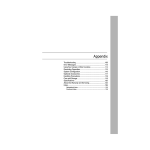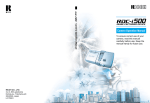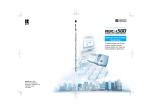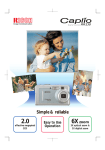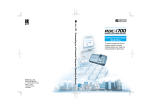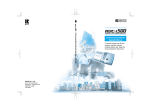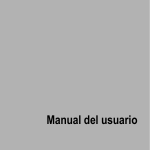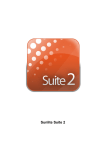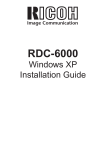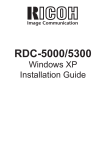Download Samsung RDC-I500 Camcorder User Manual
Transcript
Communication/Internet Operation Manual RICOH CO., LTD. 3-2-3, Shin-yokohama Kohoku-ku, Yokohama-shi 222-8530, Japan L2172552 Communication/Internet Operation Manual To ensure correct use of your camera, read this manual carefully before use. Keep the manual handy for future use. Introduction Ricoh Service Offices Thank you for purchasing a Ricoh RDC-i500. This manual explains the correct handling procedures and precautions for your camera. To ensure the best performance, please read the manual thoroughly before using the camera. Keep the manual handy for quick future reference. Ricoh Co., Ltd. 3-2-3, Shin-yokohama Kohoku-ku, Yokohama-shi 222-8530, Japan http://www.ricoh.co.jp/r_dc Test Shots Check that your camera is recording the images correctly by taking a number of test shots. Ricoh Factory Service Center 3235 Sunrise Blvd., Suite2 Rancho Cordova, CA 95742 http://www.ricohzone.com/ Copyright Reproduction or alteration of copyrighted documents, magazines, music and other materials, other than for personal, home or similarly limited purposes, without the consent of the copyright holder is prohibited. Exemption from Liability Ricoh Co., Ltd. assumes no liability for failure to record or play back images caused by malfunction of the RDC-i500. Warranty This product is manufactured to local specifications and the warranty is valid within the country of purchase. Should the product fail or malfunction while you are abroad, the manufacturer assumes no responsibility for servicing the product locally or bearing the expenditure incurred therefor. Radio Interference Operating the RDC-i500 in the vicinity of other electronic equipment may adversely affect the performance of both devices. In particular, operating the camera close to a radio or television may lead to interference. If interference occurs, follow the procedures below. – Move the camera as far away as possible from the TV, radio or other device – Reorient the TV or radio antenna. – Plug the devices into separate electrical outlets. • This publication may not be reproduced in whole or part without the express written permission of Ricoh. ©2001 Ricoh Co., Ltd. All rights reserved. • Ricoh reserves the right to change the contents of this publication without notice. Considerable care was taken in preparing this manual. If, however, you have questions about any part of the manual, or note mistakes or inaccuracies, please contact us at the address listed on the back cover. Microsoft, MS and Windows are registered trademarks of Microsoft Corporation in the United States of America and other countries. Macintosh is a registered trademark of Apple Computer, Inc., in the United States of America and other countries. CompactFlash is a registered trademark of SunDisk Corporation in the United States of America. SmartMedia is a trademark of Toshiba Corporation. All trademarked company and product names mentioned in this manual are the property of their respective owners. Ricoh Europe B.V. Photo Products Division P.O. Box 75640 1118 ZR Schiphol The Netherlands http://www.ricoh-red.com/ htttp://www.ricoh-europe.com/ E-mail:[email protected] Ricoh Europe B.V. Düsseldorf Branch Photo Products Division Oberrather Straße 6 D-40472 Düsseldorf Germany Ricoh Photo Products (Asia), Ltd. Unit D, E & F 24/F., China Overseas Building 139 Hennessy Road, Wan Chai Hong Kong Ricoh Australia Pty. Ltd. 8 Rodborough Road Frenchs Forrest, N.S.W. 2086 Australia http://www.ricoh.com.au How to Use the Operation Manuals Five operation manuals are supplied with this camera. Use each operation manual as shown below to suit the purpose. Open the package ➜ Read This Before Proceeding! These instructions explain the procedure for checking the contents of the package and loading the battery to enable you to use the camera straightaway. ➜ Basic operation Camera Operation Manual This manual explains in detail the preparations to take before using the camera together with the procedures for shooting and playback using the various functions. Communication/Internet Operation Manual (this manual) This manual explains the procedures for transmitting images and using Internet functions. ➜ ➜ Using the communication and Internet functions Sending and receiving data using the camera and a PC Connecting to a Personal Computer Operation Manual This manual explains the procedures for connecting the camera to a PC, transmitting images from the camera to the PC and operating the camera from the PC. Simple Operation Guide This guide explains the basic setting procedures of recording, transmitting images and transferring them to a PC. 1 CONTENTS How to Use the Operation Manuals ...................................................... 1 Functional Contents .............................................................................. 6 Chapter 1 Before Using the Communication and Internet Functions Camera Communication and Internet Functions ................................ 10 Internet Function .................................................................................. 10 Other Communication Function ........................................................... 11 The Internet ......................................................................................... 12 What is the Internet? ............................................................................ 12 Using the Internet with This Camera ................................................... 12 How the Internet Works ....................................................................... 13 Requirements for Accessing the Internet ............................................ 14 Provider ................................................................................................ 15 Dial-Up Function .................................................................................. 15 Flow Chart ........................................................................................... 16 Chapter 2 Setting the Communication Function Preparations and Operation Flow ....................................................... 18 Operation Flow Chart ........................................................................... Have You Made a Contract With a Provider? ..................................... Preparing Information before Setting ................................................... Setting items for Communications ....................................................... 18 20 20 22 Setting a Dial-Up Account ................................................................... 24 Setting a New Dial-Up Account ........................................................... 24 Changing a Dial-Up Account ............................................................... 31 Deleting a Dial-Up Account .................................................................. 32 Setting the E-Mail Function ................................................................ 33 Setting the Mail Environment ............................................................... 33 Registering an Address in the Address Book ..................................... 38 Registering a New Address ................................................................. 38 Checking the Address Book ................................................................. 39 Setting a Preset Memo ....................................................................... 41 At the end of this manual troubleshooting for error messages, alphabetical index and index by functions are listed for your convenience. 2 Setting a Preset Memo ........................................................................ 41 Checking a Preset Memo ..................................................................... 41 Setting Quick Send ............................................................................. 43 Setting Operation ................................................................................. 43 Setting Direct Upload .......................................................................... 47 Setting Direct Upload ........................................................................... 47 Checking Direct Upload Settings ......................................................... 49 Setting FTP Upload ............................................................................. 50 Setting FTP Upload .............................................................................. 50 Checking FTP Upload Settings ............................................................ 52 Chapter 3 Connecting Communication Equipment Connecting the Camera to Communication Card .............................. 56 Connecting the Camera to an Ordinary Telephone Line .................... 56 Removing the Communication Card .................................................... 59 Checking the Modem Settings ............................................................ 60 Chapter 4 Sending Images After Shooting Image Upload Function ....................................................................... 64 Upload Method ..................................................................................... 64 Files Uploadable by This Camera ........................................................ 65 Selecting an Image .............................................................................. 65 Sending an Image Using Quick Send ................................................ 68 Sending an Image Directly to a Computer ......................................... 70 Setting Upload ...................................................................................... 70 Uploading an Image ............................................................................. 72 Sending Images as an Attachment ..................................................... 73 Setting Upload ...................................................................................... 73 Uploading an Image ............................................................................. 78 3 Chapter 5 Using the Communication and Internet Functions Using the Communication and Internet Functions ............................. 82 Types of Functions ............................................................................... 82 Using E-Mail ........................................................................................ 83 Displaying the E-mail Menu ................................................................. Composing Mail .................................................................................... Sending Mail ......................................................................................... Checking Incoming Mail (INBOX) ........................................................ Replying to and Forwarding Mail ......................................................... Resending Mail (OUTBOX) .................................................................. 83 84 86 87 91 92 Using Direct Upload ............................................................................ 95 Setting Upload ...................................................................................... 95 Uploading a File ................................................................................... 97 Uploading an HTML File ..................................................................... 98 HTML Template .................................................................................... 99 Transferring the HTML Template Files from a PC to the Camera .... 100 Creating an HTML File ....................................................................... 102 Deleting an HTML File ....................................................................... 104 Uploading an HTML File .................................................................... 105 Viewing the HTML Templates on a PC ............................................. 107 Appendix Character Input ................................................................................. 112 Troubleshooting ................................................................................ 113 Index .................................................................................................. 120 Functional Index ................................................................................. 120 Alphabetical Index .............................................................................. 124 4 Tips Terms for Communication Settings .................................................. 21 PPP ................................................................................................... 26 IP Address and Domain Name ......................................................... 26 Name Server ..................................................................................... 26 SMTP and POP ................................................................................. 34 FTP .................................................................................................... 51 URL ................................................................................................... 51 CC ..................................................................................................... 75 Reply and Forward ............................................................................ 91 Creating/Using a New Template File ................................................ 99 5 Functional Contents Choose the function you want to use and follow the procedure on each page. When You Use the Quick Send ... This function allows you to send an image simply by using the e-mail. Chapter 2 Setting the Communication Function (Setup Mode) • Setting a Dial-Up Account → P.24 • Setting the E-Mail Function → P.33 • Registering an Address in the Address Book → P.38 • Setting Quick Send → P.43 ➜ Chapter 3 Connecting Communication Equipment • → P.55 ➜ Chapter 4 Mode) Sending Images After Shooting ( • Sending an Image Using Quick Send → P.68 When You Send the Image Using the E-Mail ... This function allows you to send images attached to the e-mail. Chapter 2 Setting the Communication Function (Setup Mode) • Setting a Dial-Up Account → P.24 • Setting the E-Mail Function → P.33 ➜ Chapter 3 Connecting Communication Equipment • → P.55 ➜ Uploading the Image in Chapter 4 6 Mode Sending Images After Mode) Shooting ( • Sending Images as an Attachment → P.73 Uploading the Image in Chapter 5 Mode Using the Comunication and Internet Function ( Mode) • Using E-Mail → P.83 When You Use the Direct Upload ... This function allows you to transfer the image directly to a PC. Chapter 2 Setting the Communication Function (bMode) • Setting a Dial-Up Account → P.24 • Setting Direct Upload → P.47 ➜ Connecting to a Personal Computer (a separate volume) • Chapter 7, “Setting the Receiving PC for Direct Upload” * This section describes how to configure the receiving computer ➜ Chapter 3 Connecting Communication Equipment • → P.55 ➜ Uploading the Image in Chapter 4 Mode Sending Images After Shooting ( Mode) • Sending Images Directly to a Computer → P.70 Uploading the Image in Chapter 5 Mode Using the Comunication and Internet Function ( Mode) • Using Direct Upload → P.95 7 When You Check the Received Mail or Use the other Mail Functions ... This function allows you to send and receive mails. Chapter 2 Setting the Communication Function (Setup Mode) • Setting a Dial-Up Account → P.24 • Setting the E-Mail Function → P.33 ➜ Chapter 3 Connecting Communication Equipment • → P.55 ➜ Chapter 5 Using the Comunication and Internet Function ( • Using E-Mail → P.83 Mode) Uploading the HTML File (FTP Upload) This function allows you to upload the HTML file embedded with the image and its original image to a server (computer) where the Web page is saved. Chapter 2 Setting the Communication Function (Setup Mode) • Setting a Dial-Up Account → P.24 • Setting FTP Upload → P.50 ➜ Chapter 3 Connecting Communication Equipment • → P.55 ➜ Chapter 5 8 Using the Comunication and Internet Function ( • Uploading an HTML File → P.98 Mode + J ) 1 Chapter Before Using the Communication and Internet Functions Camera Communication and Internet Functions ................... 10 Internet Function .......................... 10 Other Communication Function ... 11 The Internet .............................. 12 What is the Internet? .................... 12 Using the Internet with This Camera ........................................ 12 How the Internet Works ................ 13 Requirements for Accessing the Internet ......................................... 14 Provider ........................................ 15 Dial-Up Function .......................... 15 Flow Chart ................................ 16 Camera Communication and Internet Functions The camera’s communication and Internet functions enable you to take advantage of the following useful functions. Internet Function ● Sending Images by E-Mail You can send and receive e-mail. This function is useful for sending images as an attachment. → P.73 “Sending Images as an Attachment”, → P.83 “Using E-Mail” Note • You can send an image by a simple few steps procedure using the quick send function. → P.68 “Sending an Image Using Quick Send” ● Uploading Images to a Homepage You can upload an HTML file to which the image has been embedded to a server where the Web page is saved. This function is useful, for example, when you want several people to see images. → P.98 “Uploading an HTML File” Send an e-mail with an attachment Computer The Internet Dial-up lines Upload the image to the homepage 10 Other Communication Function ● Sending Images to a Computer You can upload images recorded in the camera directly to a folder in the computer (server). You can use this function, for example, to send images which you have taken while being away from your office. → P.70 “Sending Images Directly to a Computer” → P.95 “Using Direct Upload” Computer (Server) Before Using the Communication and Internet Functions Office 1 Send the files to the office computer one at a time Dial-up lines 11 The Internet This section gives you an idea of how the Internet works and what you can do with this product on the Internet. What is the Internet? When a computer is connected to other computers, this is called a computer network. There are many such networks all over the world. These networks can be connected to each other by telephone line. The world’s largest computer network connected in this way is the Internet. Network Using the Internet with This Camera ● Uploading Information to a Web Page Numerous organizations, companies, individuals, etc. make a wide variety of information available on a Web page on the Internet. The Web page contains not only text information, but images, sound and motion pictures. This product allows you to embed the images you have taken into an HTML file and upload the file to a Web page. 12 You can browse the uploaded HTML file on the PC Web browser. Note • The Internet uses an information system called WWW (World Wide Web) or simply Web. Web information is supplied in the form of pages and the homepage serves as the gateway to the Web pages. How the Internet Works This section provides a simple explanation of how the Web page works and how to send and receive e-mail. ● Web Page If you request to see a Web page, the request is delivered to the server storing the Web page in question via the Internet. The server supplies the Web page in response to the request. Web Server (computer storing the Web pages) Homepage (the first page of the Web page) D Supply the homepage C Request to view the homepage The Internet E The homepage will be displayed. B WWW (information system) searches the appropriate server. A Request to view a homepage 13 1 Before Using the Communication and Internet Functions ● Communicating by E-Mail E-mail (electronic mail) is the system of exchanging messages (mail) using the Internet. Anyone who has access to the Internet can send and receive messages at will. The system has the major advantage of being able to deliver messages instantly to people living far away, regardless of distance. Basically it is text information that is exchanged, but images can also be attached. With this product, you can also transmit the images you have taken in a simple operational sequence (Quick Send) or mail them as file attachments. ● E-Mail Sending : When a message is uploaded, it is sent first to the outgoing mail server, and from there via the Internet to the receiver’s incoming mail server. Each person has their own mail box in their incoming mail server and the message is stored in the appropriate box. Receiving : The receiver can get the message from the mail box by going to their incoming mail server. Outgoing mail server Incoming mail server Sender A Receiver B D The mail C The mail will soon B The mail will be sent to reaches the mail be sent to the the outgoing mail server. incoming mail server box of receiver of receiver B. B. The Internet Mail Box F Receiver B receives the mail. E Receiver B searches the mail. Receiver B Server A Sender A sends a mail to receiver B. Sender A Requirements for Accessing the Internet To access the Internet, you need the following items in addition to your camera. The software needed for performing a mail function or uploading an HTML file to a Web page is already loaded in the camera. ● Telephone Line and Communication Card (option) Depending on the environment, you need a telephone line, communication card (CF card type), etc. By using a communication card, you can use the communication and Internet function. Details are given in Chapter 3. → P.55 “Connecting Communication Equipment”. ● Information Supplied by the Provider This information includes a telephone number, account name (name of the contractor), password, etc for accessing the Internet. 14 Provider ● Making a Contract with a Provider The provider is the company which provides the service of connecting you to the Internet. Individual access to the Internet requires a contract with a provider. When you make such a contract, you will be supplied with the necessary information for accessing the Internet. Note • If your company already has an Internet environment, you do not need ● Access Point The contractor telephones the access point supplied by the provider and is connected to the Internet via this point. Internet service provider (ISP) Access point Dial-up lines Contractor Important Note The Internet Entrance to the Internet • The provider charges a connecting fee according to the amount of use. You are also required to pay the telephone company a charge for calling the access point. • Each provider offers its own services and charges vary accordingly. For the latest information on providers, see Internet-related magazines, etc. Dial-Up Function The dial-up IP connection is used to make a connection to the Internet only when necessary. Normally, it is for accessing the Internet using the RDC-i500. To make the dial-up IP connection, the access point (dial-up destination) and other information must have already been set. → P.24 “Setting a Dial-Up Account” Note • “Dial-up IP connection” refers to being connected only when you dialed, while “dedicated connection” refers to being constantly connected to the Internet. 15 1 Before Using the Communication and Internet Functions to make a contract with a provider. In this case, the necessary information can be obtained from the system administrator . Flow Chart The following chart shows the general flow of operation, from preparation to actual use of the communication and Internet functions. Set the Communication Function ➜ Set the mode dial to [SET] (Setup mode) and set the communication function. You will need the information supplied by the provider or system administrator. → P.17 “Chapter 2” Connect the Communication Equipment ➜ Connect the camera to the communication card. → P.55 “Chapter 3” Preparations are now complete. Follow the procedures below to actually use the communication function. ➜ Send a captured Image ➜ Set the mode dial to (Play mode) and upload an image. There are various ways of doing this. Choose the upload method best suited to your purpose. → P.63 “Chapter 4” When you want to use more various functions ... Use the Communication and Internet Functions (Communication mode) to use the Set the mode dial to communication and Internet functions. As well as sending images, you can receive images and upload images to a Web page by ). using the JOB Navi. function in Play mode ( 16




















